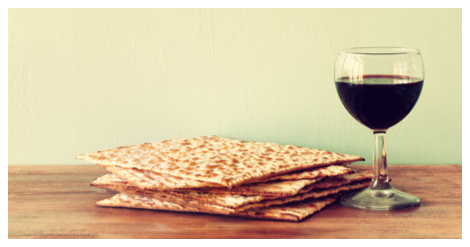
Ten Haggadot Recommendations For Your Passover Meal
Set your seder plates and hide the afikomen: Passover is here! If you’re the type who likes to add a little new flavor to each year’s Pesach celebration, varying the haggadot–the plural term for the book that outlines the order of the seder meal—your use is a great method.
Here’s a list of ten options and supplements that you might consider, with a few hints about what makes each Haggadah unlike any other. (The puns, I say with faux regret, are your plague to weather.)
Don’t–pass over!–these great haggadot:
The Maxwell House Haggadah– this is the one most folks are familiar with, because, at one point, it was on almost every American seder table, and free in many grocery stores, so: consumable and familiar. Easy to follow, it comes in pamphlet form, so it’s not hard to acquire a copy for every participant, and Hebrew with English translations makes for easy following along. Its major benefit is that it’s classic and nostalgic.
The Journey Continues: The Ma’yan Passover Haggadah– A great option for your feminist seder, not only because you won’t have to write Miriam’s cup and the orange in; they’re already there, and this haggadah even preserves the controversy over who came up with the orange. (As a woman firmly on team Heschel, I don’t personally spend much time with that passage.) Gender inclusive language and lots of good advice for using the seder as a starting off point to effect positive change in the world.
Why On This Night?: A Passover Haggadah For Family Celebration– Compiled to be approachable for children. Poems, songs, recipes, and beautiful illustrations accompany the traditional order. Reads from left to right; light on Hebrew; language of prayers not gender inclusive, though. A nice way to introduce children to the story elements of the seder, and to get them excited about their part in it, which can be more involved than just a few questions.
The Haggadah (Artscroll Mesorah)– for the learnin’ inclined amongst you. Probably actually better for study, and not for leading a seder, unless you’re leading a seder amongst, say, fellow theology students. This edition (is gorgeous and) incorporates Talmudic/halachic explanations for each moment in the seder, including for preparation in advance of it. Is largely intended to help those who read it “find [their] own way to unlock the treasures of…Pesach.” (Yeah, I made that gender neutral myself.)
New American Haggadah– or, the book nerd’s haggadah of choice, as it was compiled by Jonathan Safran Foer and translated by Nathan Englander. Foer incorporates the words and thoughts of fellow writers and Jewish thinkers at each stage of the seder; mini essays run through the pages, arranged in visually stimulating ways, and you can choose to highlight those that move you most. This is a great option, and definitely a necessary addition to any haggadot collection.
The Women’s Haggadah– for a brief, wholly feminist, very modern seder, this is a great option. It doesn’t just incorporate women’s symbols like the cup of Miriam; it makes women central–in the story of the exodus, and in every internal consideration of how Pesach has traditionally been celebrated, right down to using “shekhinah”–thought of as the feminine spirt of the divine–to address God, rather than any traditionally masculine moniker. A really healthy way to remember the exodus from wholly a women’s perspective.
The Family Haggadah— positives first? This is inexpensive and thorough and compact. It is NOT, say, ideal for those of us who decide to buy haggadot to lead seders for the first time, who are sharing a table with those not fluent in Hebrew (who are, perhaps, not fluent themselves, even), and who feel compelled to change every masculine reference to a feminine one as they lead. In such situations, this haggadah leads to a seder that falls apart very quickly. But is it really this haggadah’s fault if it falls into such hands? (Highlighters work well, if you want to trim it for use in following years. Hypothetically.)
The Union Haggadah– I’m linking the 1923 version intentionally. This is Reform Judaism’s contemporary answer to the seder from almost a century ago. It’s very worth having, not only to see how traditions develop and change, but for a means of examining how we’re still all stretching in the tradition. For those who want to celebrate the fact that Passover, though a celebration of an escape that took place millennia ago, is very much a holiday for living Jewish communities.
Build Your Own Haggadah– so many great published options! Still, sometimes someone else’s version of a haggadah doesn’t hit all the notes you want. For those of us who want to add our own touch, there are sites like Haggadot.com for building your own, and others, like Reform Judaism and the American Jewish World Service, tend to provide printable supplements for social justice themes. It is easy to find supplements like this Black Lives Matter one to recognize contemporary movements for freedom.
You can also get creative–my Hebrew school class came up with a list of ten modern “plagues,” including homelessness and global warming, that we decided to mention alongside the biblical plagues at our family tables.
The Non-Haggadah, skipping the seder option– for the truly secular amongst us: if you’re not into traditional Pesach observance, but still want to connect to the community in some way, you can always read Geraldine Brooks’s literary preservation/adventure novel, People of the Book, which traces the priceless Sarajevo Haggadah across centuries. A very worthwhile way to observe but not.
BONUS–somebody please write this Haggadah: Haggadah Davida. We’ll call it a hard rock way to observe the seder, for the appearance of legitimacy. Haggadah Davida, honey–it’s yours, if you’re up for it. All I ask is that you send me a copy once it’s done; I’m eager to reference it freely.
Feel free to name your favorite Haggadah in the comments section, and Chag Sameach!

















